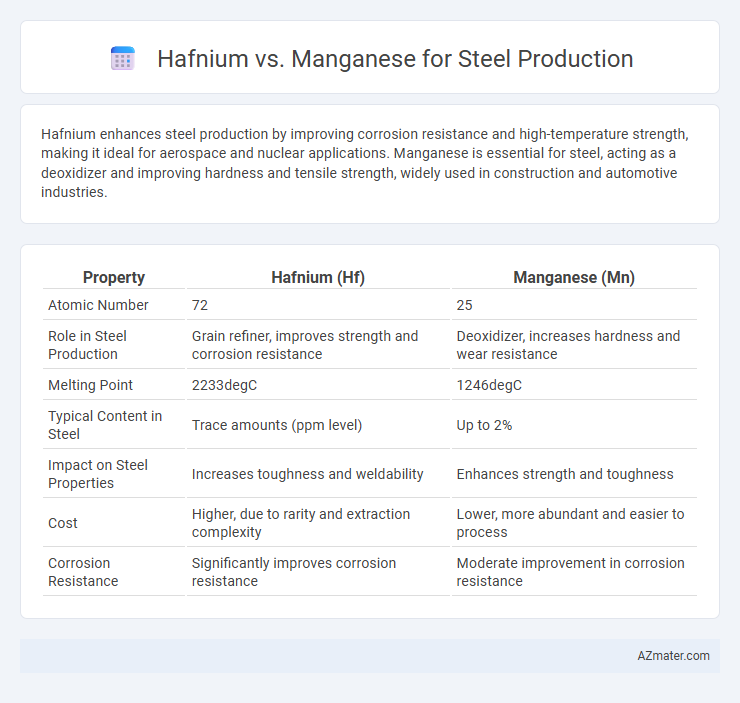Hafnium enhances steel production by improving corrosion resistance and high-temperature strength, making it ideal for aerospace and nuclear applications. Manganese is essential for steel, acting as a deoxidizer and improving hardness and tensile strength, widely used in construction and automotive industries.
Table of Comparison
| Property | Hafnium (Hf) | Manganese (Mn) |
|---|---|---|
| Atomic Number | 72 | 25 |
| Role in Steel Production | Grain refiner, improves strength and corrosion resistance | Deoxidizer, increases hardness and wear resistance |
| Melting Point | 2233degC | 1246degC |
| Typical Content in Steel | Trace amounts (ppm level) | Up to 2% |
| Impact on Steel Properties | Increases toughness and weldability | Enhances strength and toughness |
| Cost | Higher, due to rarity and extraction complexity | Lower, more abundant and easier to process |
| Corrosion Resistance | Significantly improves corrosion resistance | Moderate improvement in corrosion resistance |
Introduction to Alloying Elements in Steel
Hafnium and manganese are crucial alloying elements enhancing steel's mechanical properties and corrosion resistance. Manganese, commonly used at concentrations of 0.3-2%, improves hardenability, tensile strength, and deoxidizes molten steel, making it vital in most steel grades. Hafnium, though less common and more expensive, refines grain structure and boosts creep strength, particularly in high-temperature and specialized alloy steels.
Overview of Hafnium in Steel Production
Hafnium enhances steel production by improving corrosion resistance and high-temperature strength, making it valuable for specialty steel alloys. Its addition refines grain structure and stabilizes carbides, contributing to improved toughness and durability. Compared to manganese, which primarily acts as a deoxidizer and influences hardness, hafnium's unique metallurgical properties support advanced applications in aerospace and nuclear industries.
Overview of Manganese in Steel Production
Manganese is a critical alloying element in steel production, valued for its ability to improve hardness, tensile strength, and wear resistance by acting as a deoxidizer and sulfur fixer during steelmaking. It enhances steel's durability and toughness by removing oxygen and sulfur impurities, which otherwise cause brittleness and reduce performance. Commonly used in construction steel and high-strength steel alloys, manganese enables the production of steels suitable for structural and industrial applications.
Chemical Properties: Hafnium vs Manganese
Hafnium exhibits a high melting point of 2233degC and exceptional corrosion resistance, making it valuable in steel alloys for enhancing strength and oxidation resistance at elevated temperatures. Manganese, with a melting point of 1246degC, primarily improves steel hardness, tensile strength, and wear resistance while aiding in deoxidizing and removing sulfur impurities during steelmaking. Chemically, hafnium's ability to form stable carbides and nitrides contrasts with manganese's role as an effective deoxidizer and alloying element that stabilizes austenite in steel microstructures.
Impact on Mechanical Strength
Hafnium enhances steel production by significantly improving mechanical strength through grain refinement and precipitation hardening, leading to superior toughness and resistance to deformation. Manganese primarily contributes to strength by increasing tensile strength and hardness while also improving ductility and toughness through the formation of manganese sulfides. The combined use of hafnium and manganese in steel alloys optimizes mechanical strength characteristics, balancing hardness, toughness, and weldability for advanced industrial applications.
Corrosion Resistance Comparison
Hafnium significantly enhances corrosion resistance in steel alloys due to its ability to form stable oxide films that protect against oxidation and chemical degradation. Manganese, while improving hardness and tensile strength, offers limited corrosion resistance compared to hafnium, especially in high-temperature or aggressive environments. Steel alloys containing hafnium demonstrate superior durability and longevity in corrosive applications, making hafnium a preferred additive for advanced corrosion-resistant steel production.
Effects on Steel’s Microstructure
Hafnium in steel production significantly refines grain size, promoting enhanced toughness and resistance to creep by stabilizing carbides and nitrides within the microstructure. Manganese acts primarily as a deoxidizer and strengthens steel through solid solution strengthening, influencing hardness and tensile strength by modifying austenite stability and pearlite formation. The combination of hafnium's grain refinement with manganese's strengthening effects results in steels with superior mechanical properties and improved thermal stability for high-performance applications.
Cost and Availability in the Market
Hafnium is significantly more expensive and less abundant than manganese, making it a costly choice for steel production despite its beneficial properties like high corrosion resistance and strength enhancement. Manganese is widely available and economically feasible, serving as a critical alloying element to improve steel hardness and durability at a fraction of hafnium's cost. Market availability heavily favors manganese, ensuring stable supply chains for large-scale steel manufacturing.
Environmental and Safety Considerations
Hafnium in steel production offers superior corrosion resistance and thermal stability, reducing the need for frequent replacement and minimizing environmental waste. Manganese, widely used as a deoxidizer and alloying element, poses health risks due to inhalation of dust and fumes, necessitating strict safety measures for workers. The environmental impact of manganese mining and processing contributes to ecological degradation and air pollution, whereas hafnium's limited supply and higher cost pose challenges for sustainable scaling.
Choosing the Right Alloying Element for Your Application
Hafnium offers superior grain refinement and improves high-temperature strength in steel, making it ideal for applications requiring enhanced durability and resistance to thermal degradation. Manganese is essential for deoxidizing steel and improving toughness and wear resistance, particularly in structural and tool steels. Selecting between hafnium and manganese depends on the steel's intended use, balancing cost-effectiveness with the desired mechanical properties and environmental conditions.

Infographic: Hafnium vs Manganese for Steel Production
 azmater.com
azmater.com